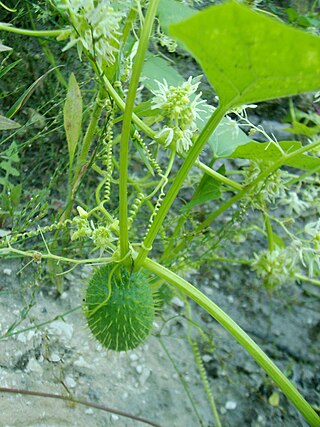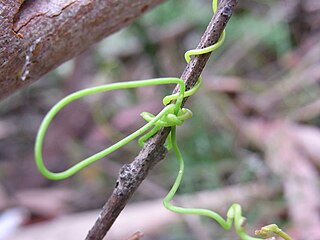
Cuscuta, commonly known as dodder or amarbel, is a genus of over 201 species of yellow, orange, or red parasitic plants. Formerly treated as the only genus in the family Cuscutaceae, it now is accepted as belonging in the morning glory family, Convolvulaceae, on the basis of the work of the Angiosperm Phylogeny Group. The genus is found throughout the temperate and tropical regions of the world, with the greatest species diversity in subtropical and tropical regions; the genus becomes rare in cool temperate climates, with only four species native to northern Europe.

Kudzu, also called Japanese arrowroot or Chinese arrowroot, is a group of climbing, coiling, and trailing deciduous perennial vines native to much of East Asia, Southeast Asia, and some Pacific islands, but invasive in many parts of the world, primarily North America.

Pueraria montana is a species of plant in the botanical family Fabaceae. At least three sub-species are known. It is closely related to other species in the genus Pueraria and the common name kudzu is used for all of these species and hybrids between them. The morphological differences between them are subtle, they can breed with each other, and it appears that introduced kudzu populations in the United States have ancestry from more than one of the species.

Lauraceae, or the laurels, is a plant family that includes the true laurel and its closest relatives. This family comprises about 2850 known species in about 45 genera worldwide. They are dicotyledons, and occur mainly in warm temperate and tropical regions, especially Southeast Asia and South America. Many are aromatic evergreen trees or shrubs, but some, such as Sassafras, are deciduous, or include both deciduous and evergreen trees and shrubs, especially in tropical and temperate climates. The genus Cassytha is unique in the Lauraceae in that its members are parasitic vines. Most laurels are highly poisonous.

Cassytha is a genus of some two dozen species of obligately parasitic vines in the family Lauraceae. Superficially, and in some aspects of their ecology, they closely resemble plants in the unrelated genus Cuscuta, the dodders. When fruit and flowers are absent in the field, the physical resemblance is so close that few people without technical training can discern the difference. In this respect and in their ecology the two genera present a spectacular example of convergent evolution. Nonetheless, Nickrent comments that "Cassytha is uneqivocally assigned to Lauraceae based on (both) morphological and molecular data." In its divergence from habits typical of the Lauraceae, Cassytha also presents examples of mosaic evolution

Clematis virginiana is a vine of the Ranunculaceae native to North America from Newfoundland to southern Manitoba down to the Gulf of Mexico. The rationale for some of the common names is unclear, as they include examples normally applied to unrelated plants, including twining parasites. The name "Love Vine" also is applied to alleged aphrodisiacs, such as Caribbean species of Cassytha, which are unrelated to Clematis, not being in the family Ranunculaceae.
Kudzu, a climbing, coiling, and trailing vine in the genus Pueraria, native to southern Japan and southeast China
Balsam apple may refer to:

Ipomoea lobata, the fire vine, firecracker vine or Spanish flag, is a species of flowering plant in the family Convolvulaceae, native to Mexico and Brazil.
The Kuzu were a people of ancient Japan.

Cassytha melantha is a parasitic vine. Common names include coarse dodder-laurel and large dodder-laurel. The fruits are about 10–15 millimetres (0.39–0.59 in) in diameter and are green, drying to black. These are edible and are harvested in the wild.

Echinocystis is a monotypic genus in the gourd family, Cucurbitaceae. The sole species is E. lobata, commonly called wild cucumber, prickly cucumber or bur cucumber. It is an annual, sprawling plant that is native to North America.

Kudzu is an invasive plant species in the United States, introduced from Asia with devastating environmental consequences, earning it the nickname "the vine that ate the South". It has been spreading rapidly in the Southern United States, "easily outpacing the use of herbicide, spraying, and mowing, as well increasing the costs of these controls by $6 million annually". Estimates of the vine's spread vary, from the United States Forest Service's 2015 estimate of 2,500 acres per year to the Department of Agriculture's estimate of as much as 150,000 acres annually.

Cassytha glabella, commonly known as the slender devil's twine, is a common twining plant of the Laurel family, found in many of the moister parts of Australia. A hemi-parasitic climber. The specific epithet glabella is from Latin, referring to the lack of hairs. The fruit are sweet and mucousy to taste. The Devil's Twine and Cassytha melantha are similar, but with thicker hairier stems.

Urena lobata, commonly known as Caesarweed or Congo jute, is a tender perennial, variable, erect, ascendant shrub or subshrub measuring up to 0.5 meters (1.6 ft) to 2.5 meters (8.2 ft) tall. The stems are covered with minute, star-like hairs and often tinged purple. Considered a weed, it is widely distributed in the tropics, including in Brazil and Southeast Asia.

Cassytha filiformis or love-vine is an orangish, wiry, parasitic vine in the family Lauraceae. It is found in coastal forests of warm tropical regions worldwide including the Americas, Indomalaya, Australasia, Polynesia and tropical Africa.
Bur cucumber is a common name for several plants and may refer to:

Pueraria montana var. lobata, the East Asian arrowroot, or kudzu vine, is a perennial plant in the family Fabaceae.












